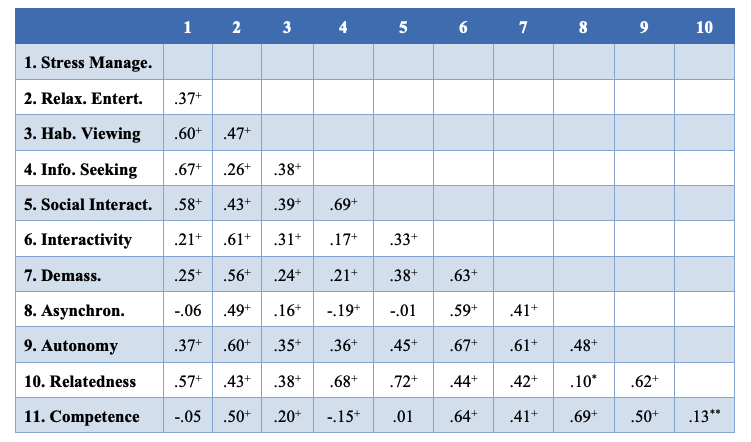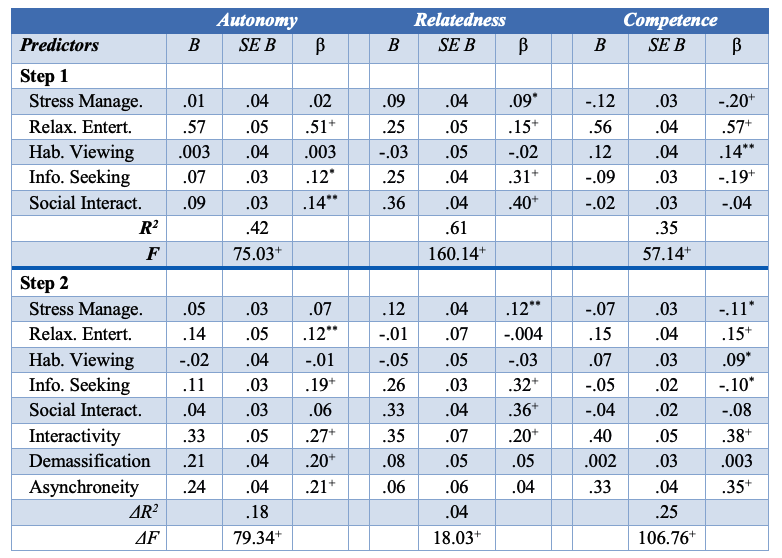Alec Tefertiller
Baylor University
The past several years have seen the rapid roll-out of a number of streaming video-on-demand entertainment services, such as Apple TV, Disney+, and more. This study sought to determine if there was a relationship between gratification needs and self-determination orientations for the use of SVOD services. Using a national survey (N = 529), it was determined that traditional gratifications contribute to all three dimensions of self-determination – autonomy, relatedness, and competence.
Keywords: self-determination theory, uses and gratifications, streaming video-on-demand services, media satisfaction
- Citation
- Author

Alec Tefertiller (Ph.D., Oregon, 2017) is an Assistant Professor in the Department of Journalism, Public Relations & New Media at Baylor University in Waco, TX, USA. His research focuses on new media technology adoption and motivations. He has published research on social media, cable cord-cutting, the use of streaming video-on-demand services, modern television motivations, and binge-watching.
Author Note:
Correspondence concerning this article should be addressed to Alec Tefertiller, One Bear Place #97353, Waco, TX 76798-7353. Phone: 254-710-6348. Fax: 254-710-3363. Email: Alec_Tefertiller@baylor.edu The author has no competing interests to declare that are relevant to the content of this article. Alec Tefertiller: https://orcid.org/0000-0002-3933-5276.
Introduction
The past several years have seen a marked increase in the availability of streaming video-on-demand services (SVOD), with major media conglomerates joining Netflix and Amazon as streaming entertainment providers. Apple, Disney, Viacom, Discovery, Warner Media, and NBC Universal have introduced their own streaming services, with varying rates of adoption. It is estimated that 80% of U.S. households have subscribed to an SVOD service, though the rapid adoption is giving way to a period of slow or flat growth as the number of services has increased and people have begun to return to pre-pandemic activities (Adgate, 2021). Given the rise in competition, it is worth exploring what factors contribute to the ongoing success of streaming channels as sources of at-home, televised entertainment.The content created and curated through streaming channels is often directly derived or designed to emulate the categories of content created and broadcast through legacy media, such as hour-long dramatic series, half-hour comedies, reality programs, etc. (Wayne, 2018). However, the fact that streaming providers have the ability to provide both depth and volume of on-demand entertainment has led to the creation of unique behaviors associated with streaming technology. For example, SVOD’s deep back-catalogs of television reruns serve as a historical archive where the “role of the viewer has been re-envisioned as an active curator of content” (Gilbert, 2019, p. 698). In addition, binge-watching is the act of watching multiple episodes of a television series within a time-frame determined by the user, and the technological affordances of streaming television facilitate and encourage this user practice (e.g. Pittman & Sheehan, 2015; Rubenking et al., 2018; Viens & Farrar, 2021).
The creation of new television watching behaviors such as binge-watching and user curation provides the opportunity to examine television through new theoretical lenses. Traditionally, research has examined user motivations for using media in terms of its ability to meet psychological needs (Katz et al., 1973, 1974), with ample attention paid to television (Rubin, 1981, 1983). However, the evolution of television into an online, interactive media through streaming provides the opportunity to understand how the affordances of the technology might impact the way it meets individual needs (Ruggiero, 2000). The ability of interactive media technology, such as video games, to meet needs has been explored through another theoretical approach: self-determination theory (Tamborini et al., 2010). Self-determination theory (Deci & Ryan, 1985) posits that individuals’ intrinsic motivation and well-being are the products of their ability to competently and autonomously manage their lives, with positive relatedness with those around them.
Given the interactive, web-based affordances of SVOD channels, there is an opportunity to explore the relation of the gratifications of both the content and technological affordances of steaming media to the individual self-determination facilitated by the channels. Is there a relation between gratifications and self-determination? Using a cross-sectional, national survey, this study seeks to better understand individual motivations for using streaming channels through their ability to foster self-determination.
Literature Review
Self-Determination Theory
Self-determination theory (Deci & Ryan, 1985) argues individuals’ self-realization and personal well-being is satisfied by the fulfillment of basic needs. We have three basic psychological needs: autonomy, relatedness, and competence (Ryan & Deci, 2000), and by fulfilling these needs, we achieve self-actualization (Ryan & Deci, 2001) and are motivated by internal, self-defining goals, known as intrinsic motivations, rather than external rewards, or extrinsic motivations (Deci & Ryan, 2008).
According to Ryan and Deci (2000), our intrinsic motivations are fostered by feelings that we are capable and have self-efficacy in our actions, and that efficacy is supported by positive feedback from our social connections with whom we engage in activities. However, competence and relatedness do not feed a sense of intrinsic motivations without a sense of autonomy, defined as an “internal perceived locus of causality” (p. 70). Our sense of self-determination is therefore guided by the feeling that we have some sense of control over our actions, that we are sufficiently capable of performing those actions, and we have positive interactions and relationships with those around us. For Ryan and Deci, a need “is an energizing state that, if satisfied, conduces toward health and well-being but, if not satisfied, contributes to pathology and ill-being” (p. 74). In other words, meeting our needs for autonomy, relatedness and competence is key to our mental health and sense of well-being.
Media research has examined media satisfaction through the lens of self-determination through the enjoyment of video games (Tamborini et al., 2010). It has been demonstrated that both hedonic, such as arousal, and non-hedonic, such as competence and autonomy, satisfaction is met through satisfactory video game play (Tamborini et al., 2011). Furthermore, research suggests that the continued acceptance of media technology is motivated by the technology’s ability to promote autonomy, competence, and relatedness, which influence the perception of the media’s usability and ease-of-use (Nikou & Economides, 2014). Understanding media satisfaction as the satisfaction of intrinsic needs provides the opportunity to connect media use with individuals’ overall sense of well-being and self-realization.
Uses and Gratifications
While self-determination theory connects media use to the satisfaction of needs, the use of media for need satisfaction is not a new concept in media research. Evolving from media effects research undertaken in the middle of the last century, the uses and gratifications framework posits that audiences use media to meet psychological and social needs (Katz et al., 1973, 1974). According to Katz et al. (1974), uses and gratifications research is “concerned with: (i) the social and psychological origins of (2) needs, which generate (3) expectations of (4) the mass media or other sources, which lead to (5) differential patterns of media exposure (or engagement in other activities), resulting in (6) need gratifications and (7) other consequences, perhaps mostly unintended ones” (p. 510).
While Katz et al. identified four basic categories of gratifications: 1) escape, 2) social utility and personal relationship building, 3) personal identity exploration and reinforcement, and 4) surveillance or information-seeking (Katz et al., 1974; McQuail et al., 1972), many different categories have been identified and associated with various media formats, ranging from traditional media such as television and newspapers to new media such as YouTube and social networks (see Sundar & Limperos, 2013). Much recent uses and gratifications research has focused on social media channels such as Facebook, Instagram, Twitter, and Snapchat (e.g. Chen, 2011; Malik et al., 2015; Phua et al., 2017; Punyanunt-Carter et al., 2017; Raacke & Bonds-Raacke, 2008), with additional attention paid to new media technologies such as smartphones (Hiniker et al., 2016), virtual reality (Ball et al., 2021) and augmented reality (Hamari et al., 2019).
The Gratifications of Television and Streaming Video
While recent uses and gratifications has focused on newer technologies, television has a long history of gratifications research (e.g. Babrow & Swanson, 1988; McQuail et al., 1972; Rubin, 1981, 1983, 1984). Rubin (1983) identified five categories of viewing motivations for television: pass time/habit, information seeking, entertainment, companionship, and escape. With the exception of escape, all of these viewing motivations were positively associated with viewing time and affinity for the television medium, with watching television to relieve boredom or pass time and watching television for entertainment purposes best predicting both viewing and affinity.
With the advent of newer television technologies, most notably streaming, Tefertiller and Sheehan (2019) sought to understand if the same categories of television gratifications exerted the same influence as those determined by research conducted during the analog, broadcast-dominant age (Rubin, 1981, 1983). Tefertiller and Sheehan (2019) identified similar but distinct categories of viewing that frame television viewing as a unique set of behaviors existing within a complex, multi-media ecosystem. Individuals turn to television for stress management, relaxing entertainment, habitual viewing, information seeking, and social interaction. Viewing streaming television was associated with all five motivations, but most notably relaxing entertainment.
While the motivations for viewing streaming television – and presumably the use of streaming channels – have been identified, what is not clear is how these motivations relate to the dimensions of self-determination in the use of streaming channels. While research suggests media use is tied to the fulfillment of basic needs through self-determination (Tamborini et al., 2010, 2010), no clear connection has been established between gratification seeking and the fulfillment of the basic needs of self-determination, much less in the context of interactive SVOD channels. As such, the following research question is proposed:
RQ1: Do the gratifications of SVOD services influence the three dimensions of self-determination: autonomy, relatedness, and competence?
The Active Audience and Technology
While much uses and gratifications research has focused on the particular need motivations of using television (Rubin, 1983, 1984; Tefertiller & Sheehan, 2019), a key concept of uses and gratifications theory is the notion of the active audience (Blumler, 1979). Blumler argues that audiences are active in their media consumption across three temporal dimensions of media experiences. Audiences pre-select the content they wish to consume, they pay varying levels of attention during consumption, and finally, they elaborate on their experiences through reflection and conversations after consuming. As such, the gratification process becomes an active experience in which the audience dictates their gratification levels through their involvement.
With the advent of new television technologies in the 1980s, uses and gratifications examined the use of these innovations to facilitate the gratification-seeking process through selective viewing. Innovations like the remote control device (RCD), videocassette recorder (VCR), and cable television box were given ample consideration regarding their gratifications (Ferguson, 1994; Perse & Ferguson, 1993; Walker & Bellamy, 1991). For example, channel changing via an RCD was associated with a variety of gratification motivations (Perse & Ferguson, 1993), in addition to providing unique affordances through the avoidance of undesirable content, such as advertising and political content (Walker & Bellamy, 1991).
In regards to recent television viewing behaviors facilitated by streaming television, much attention has been paid to binge-watching (Flayelle et al., 2019; Pittman & Sheehan, 2015; Rubenking et al., 2018). Motivations for binge-watching include increased engagement with the content, which then motivated planning behaviors and the frequency of viewing (Pittman & Sheehan, 2015). While binge-watching has been associated with negative outcomes, such as a loss of control (Flayelle et al., 2019), the technology itself, including the functionality of streaming services, has been shown to motivate anticipation and continued viewing (Rubenking et al., 2018).
The study of new television technologies and the increased functionality facilitated by these technologies suggests that the active role audiences take in their television gratification experiences is a product of the interactive role afforded by the innovations. Sundar and Limperos (2013) have posited that these affordances – the result of modern, web-based technologies – may meet viewer gratifications in and of themselves, rather than simply facilitating audience activity. This is consistent with past research regarding RCD use (Walker & Bellamy, 1991) and more recent binge-watching research (Rubenking et al., 2018). As such, understanding the particular affordances of streaming channels is important.
Interactivity, Demassification, and Asynchroneity. Ruggiero (2000) posited that three concepts facilitated by computer-based technology would be fundamental in understanding the uses of new media: interactivity, asynchroneity, and demassification. Interactivity refers to the control users exert over the medium, including the ability to give the communication system commands. Asynchroneity refers to a medium’s ability to send and receive messages on a staggered timeline, where users can exchange messages at their convenience. Demassification is “the ability of the media user to select from a wide menu” (p. 16). As Tefertiller (2018) has asserted, streaming television has provided audiences the ability to assert control over their experience, be free from broadcast schedules, and access a deep and wide catalog of content; in fact, the absence of these affordances is a strong predictor of abandoning broadcast television in favor of streaming channels.
This is consistent with previous research that suggests control over the television medium, specifically through the use of digital video recording popular in the early 2000s, was associated with satisfaction and other gratifications obtained through television (Ferguson & Perse, 2004). As suggested through previous research, the affordances of digital media help to facilitate self-determination (Nikou & Economides, 2014). As such, it is possible that the interactive, asynchronous, and demassified nature of streaming technologies might also contribute to self-determination while using these technologies. The following research question is proposed:
RQ2: Do the affordances of SVOD services related to interactivity, demassification, and asynchroneity influence the three dimensions of self-determination?
Method
To address the research questions, an online cross-sectional survey was conducted utilizing Qualtrics survey software. Upon approval from the university institutional review board, the survey was distributed via Amazon’s Mechanical Turk (M-Turk) system. To improve data quality, best practices regarding completion rate (98%) and total completed hits (5000) were observed, with reCAPTCHA and three open-ended task questions used to limit responses from automated bots. The open-ended task questions asked users to answer a query such as “three times three =,” with only correct answers accepted. In addition, four standard attention checks were employed. Respondents had to correctly select a desired answer choice as instructed by survey items at least three times randomly during the survey. Respondents were also asked to indicate the last program they watched using their SVOD service. Respondents who failed more than one attention check or who provided a nonsensical response to the open-ended response were eliminated from the final sample.
In addition, to participate, respondents were required to have subscribed to at least one of the following SVOD services in the past year: Amazon Prime, Apple TV, Discovery+, Disney+, fuboTV, HBO Max, Hulu, Netflix, Paramount+, Peacock, Philo, Sling TV, and YouTube TV. These channels were chosen for prominence (i.e Netflix, Amazon Prime, Hulu), representing major industry conglomerates (i.e. Disney+, Discovery+, Paramount+, etc.) and providing live television (Sling TV, fuboTV, etc.)
A total of 551 responses were collected, with 22 responses eliminated due to failed attention checks, leaving a total sample of 529. The gender distribution was 59.6% male (n = 315), 39.9% female (n = 211), with 0.6% self-identifying or not disclosing (n = 3). The average age of the sample was 37 (SD = 9.96). The racial distribution of the sample was 80.5% Caucasian (n = 426), 8.3% Black or African American (n = 44), 5.7% Asian (n = 30), 4% Hispanic or Latino (n = 21), 1.3% American Indian or Alaska Native (n = 7), and 0.2% Native Hawaiian or Other Pacific Islander (n = 1).
Procedure
Upon reviewing informed consent and agreeing to participate in the survey, after passing reCAPTCHA and the open-ended data quality measures, and after completing demographic questions, respondents were asked to indicate the streaming channels they subscribed to within the past year. From the channels they selected, respondents were randomly assigned one SVOD channel for which they would respond to the remaining items in the survey. Table 1 presents respondent subscription data as well as selected channel data for each SVOD service included in the study. Respondents then completed the remaining survey items, which were customized using piped text within survey items for their randomly assigned SVOD channel.
Table 1
SVOD Service Subscription and Study Selection Counts (N = 529)
 Note. Study participation indicates the amount the SVOD service was randomly assigned to study participants. Survey items were particular to the assigned service.
Note. Study participation indicates the amount the SVOD service was randomly assigned to study participants. Survey items were particular to the assigned service.
Measures
Gratifications from SVOD services were measured using the television gratification scales identified by Tefertiller and Sheehan (2019), based on previous scales (Rubin, 1981, 1983). There were five gratifications whose items were measured using 5-point, Likert scales ranging from “strongly disagree” to “strongly agree.” Stress Management (M = 3.31, SD = .94, α = .86) was measured using six items such as, “I use [service] so I can forget about school, work, or other things.” Relaxing Entertainment (M = 4.05, SD = .57, α = .82) was measured using eight items, including, “I use [service] because it entertains me.” Habitual Viewing (M = 3.76, SD = .68, α = .70) was measured using five items such as, “I use [service] because it’s a habit, just something to do.” Information Seeking (M = 3.11, SD = 1.16, α = .86) was measured using three items such as, “I use [service] so I can learn how to do things which I haven’t done before.” Finally, Social Interaction (M = 3.42, SD = 1.02, α = .78) was measured using three items including, “I use [service] so I can talk with other people about what’s on.”
Perceived interactivity (M = 4.09, SD = .53, α = .74) was measured using a scale from Leiner and Quiring (2008). The scale included six items measured on 5-point, Likert scales ranging from “strongly disagree” to “strongly agree.” Items included, “[Service] is versatile,” and “[Service] is up-to-date.”
Demassification and asynchroneity were measured with items selected from Tefertiller (2018). Each scale included five items measured using 5-point, Likert scales ranging from “strongly disagree” to “strongly agree.” Demassification (M = 4.00, SD = .63, α = .79) included items such as “[Service] has a large catalog of programs from which I can choose the exact program I wish to watch,” with three new items: “I can usually find something to watch on [service],” “[Service] has a lot of programs to choose from,” and “[Service] has a wide variety of programs to choose from.” Asynchroneity (M = 4.30, SD = .58, α = .84) included items such as “[Service] allows me to watch a program at a time I choose,” as well as two new items: “Using [service], I can choose to start a program whenever I want,” and “[Service] lets me watch on my own schedule.”
Self-determination variables were measured using three scales adapted from Schultz et al. (2015) designed to capture respondent autonomy, relatedness, and competence. Each scale consisted of four items measured on 5-point, Likert scales ranging from “strongly disagree” to “strongly agree.” Autonomy (M = 3.93, SD = .64, α = .70) included items such as “Using [service], I feel a sense of choice and freedom in the things I watch.” Relatedness (M = 3.50, SD = .94, α = .87) included items such as “I feel connected with people who use [service].” Competence (M = 4.30, SD = .56, α = .74) included items such as “I feel capable at using [service].”
Results
To address the research questions, a series of regressions were used with the self-determination factors, autonomy, relatedness, and competence, as criterion variables. The first step of each regression entered the five gratification variables: 1) stress management, 2) relaxing entertainment, 3) habitual viewing, 4) information seeking, and 5) social interaction. The second step of each regression entered the technical affordance variables: 1) interactivity, 2) demassification, and 3) asynchroneity. No tolerances were below .2, and no variance inflation factors exceeded 4.0 for any variables in any step of the regressions, suggesting a lack of multicollinearity. Table 2 presents correlations for all variables included in the regressions. Table 3 presents the results of the three regressions.
Table 2
Correlations Between Gratification and Self-Determination Variables (N = 529)

Note. Manage. = Management, Relax. = Relaxing, Entert. = Entertainment, Hab. = Habitual, Info. = Information, Interact. = Interaction, Demass. = Demassification, Asynchron. = Asynchroneity.
* p < .05, ** p < .01, + p < .001
Table 3
Regressions of Self-Determination Variables on Gratification Variables (N = 529) Note. Manage. = Management, Relax. = Relaxing, Entert. = Entertainment, Hab. = Habitual, Info. = Information, Interact. = Interaction
Note. Manage. = Management, Relax. = Relaxing, Entert. = Entertainment, Hab. = Habitual, Info. = Information, Interact. = Interaction
* p < .05, ** p < .01, + p < .001
For autonomy, the introduction of the gratification variables in step one explained 42% of the variance, F(5, 523) = 75.03, p <.001. Relaxing entertainment (β = .51, p < .001), information seeking (β = .12, p = .02), and social interaction (β = .14, p = .005) were significant predictors in the first step of the regression; however, only relaxing entertainment (β = .12, p = .003) and information seeking (β = .19, p < .001) were significant in the complete model. The addition of the affordance variables in step two explained an additional 18% of the variance, F(3,520) = 79.34, p < .001. Interactivity (β = .27, p < .001), demassification (β = .20, p < .001), and asynchroneity (β = .21, p < .001) were the best predictors in the overall model.
For relatedness, the gratification variables explained 61% of the variance in step one of the model, F(5,523) = 160.14, p < .001. Stress management (β = .09, p = .03), relaxing entertainment (β = .15, p < .001), information seeking (β = .31, p < .001), and social interaction (β = .40, p < .001) were all significant predictors in the model. Stress management (β = .12, p = 004), information seeking (β = .32, p < .001), and social interaction (β = .36, p < .001) continued to serve as significant predictors in the total model, with information seeking and social interaction as the best predictors. The introduction of the affordance variables only explained an additional 4% of the variance, F(3,520) = 18.03, p < .001, and only interactivity (β = .20, p < .001) was a significant predictor in the model.
Finally, for competency, the gratification variables explained 35% of the variance, F(5,523) = 57.14, p < .001. Stress management (β = -.20, p < .001), relaxing entertainment (β = .57, p < .001), habitual viewing (β = .14, p = .002), and information seeking (β = -.19, p < .001) were significant predictors in the model, though the relation was negative for stress management and information seeking. All four continued to be significant predictors in the complete model, though stress management (β = -.11, p = .01), relaxing entertainment (β = .15, p < .001), habitual viewing (β = .09, p = .02), and information seeking (β = -10, p = .03) were not the best predictors in the complete model. The introduction of the affordances in step two explained an additional 25% of the variance, F(3,520) = 106.76, p < .001. Both interactivity (β = .38, p < .001) and asynchroneity (β = .35, p < .001) were significant and were the best predictors in the model.
RQ1 asked if the gratifications of using SVOD services influence the attitudes towards self-determination users experience while using these services. While relaxing entertainment and information seeking contributed to perceived autonomy, and while relaxing entertainment and habitual viewing contributed to competence, they were not the best predictors in the overall model. Furthermore, stress management and information seeking were negative predictors of competency. However, for relatedness, information-seeking and social interaction were the best predictors. While traditional gratifications contribute to all three dimensions in varied ways, relatedness was best predicted by several gratification categories.
RQ2 asked if the affordances of SVOD services influence users’ self-determination while using the services. All three affordances were the best predictors of autonomy, while both interactivity and asynchroneity were the best predictors of competence. However, for relatedness, only interactivity was a predictor, and it was not the best predictor in the model. The affordances of the services are an important part of users’ feelings of autonomy and competence while using the service, though they play a lesser role in users’ feelings of relatedness.
Discussion
This study sought to determine if there was a relationship between gratification needs and self-determination orientations for the use of SVOD services. Based on the results of a national online survey, it was determined that traditional gratification needs contribute to all three dimensions of self-determination – autonomy, relatedness, and competence – in varied ways, though relatedness was best predicted by several gratification categories, most notably social interaction. However, the affordances of the services – interactivity, demassification, and asynchroneity – were key predictors of the user’s perceived autonomy and competence while using the services.
This study has implications for both uses and gratifications and self-determination theory, suggesting a clear connection between the needs described in both theories. Of note, the affordances of media technologies, in this case streaming services, are an important source of meeting needs related to autonomy and competence while using the services. In the context of the current study, the ability to curate a large catalog of entertainment options (demassification), view on the user’s own, self-determined schedule (asynchroneity), as well as the ability to interact with the channel through digital controls (interactivity), contributed to users’ sense of autonomy while using SVOD services. Furthermore, interactivity and asynchroneity contributed to the sense of competence. As argued by Sundar and Limperos (2013), new media presents the opportunity to understand gratifications presented by the interactive features of the media, themselves. The current study suggests the dynamic nature of media could perhaps better be understood in its ability to meet basic psychological needs tied to our intrinsic motivations.
However, it is worth noting that relaxing entertainment also had a positive relationship to autonomy and competence. As a traditional gratification category – i.e. one that is not tied to the particular affordances of the medium, but rather more associated with the particular content – it is interesting to see that meeting that need was positively related to a sense of agency and self-efficacy in using the technology. Perhaps a sense that individuals can adequately meet their needs for escape and to unwind contributes to their overall sense of self-realization. As such, entertainment media might play a more important role in our overall sense of well-being and self-actualization than has been previously realized.
The current investigation also suggests the social motivations for media use contribute to our sense of relatedness while using SVOD channels. Not surprisingly, the use of media for social connection is closely related to relatedness. Furthermore, information-seeking motivations are also connected to relatedness, suggesting that what we learn from consuming media has intrinsic social value, perhaps fueling conversations or allowing the opportunity to build social capital in our social networks through information sharing (Papacharissi & Mendelson, 2011).
Limitations and Future Research
While this investigation makes a clear connection between uses and gratifications and self-determination theory, more research is needed in other media contexts to better understand how these approaches might inform each other. A key limitation of this study is its dependence on a cross-sectional survey, which gives it limited causal application. Future research should employ experimental methods to better understand the relation between gratification seeking and the fulfillment of intrinsic needs. Another key limitation of this study is its dependence on a limited set of gratification categories tied to a particular medium. Additional traditional gratifications, as well as affordance-based gratification categories, should be explored. Finally, future research should seek to better understand the role media plays in our overall sense of well-being and self-realization as a part of the larger ecosystem of our daily activities.
References
Adgate, B. (2021, December 17). As SVOD growth slows, industry consolidation is looming. Forbes. https://www.forbes.com/sites/bradadgate/2021/12/17/as-svod-subscriptions-slows-industry-consolidation-is-looming/?sh=6090b83f2fb2
Babrow, A. S., & Swanson, D. L. (1988). Disentangling antecedents of audience exposure levels: Extending expectancy-value analyses of gratifications sought from television news. Communication Monographs, 55, 1–21.
Ball, C., Huang, K.-T., & Francis, J. (2021). Virtual reality adoption during the COVID-19 pandemic: A uses and gratifications perspective. Telematics and Informatics, 65, 101728. https://doi.org/10.1016/j.tele.2021.101728
Blumler, J. G. (1979). The role of theory in uses and gratifications studies. Communication Research, 6(1), 9–36.
Chen, G. M. (2011). Tweet this: A uses and gratifications perspective on how active Twitter use gratifies a need to connect with others. Computers in Human Behavior, 27(2), 755–762. https://doi.org/10.1016/j.chb.2010.10.023
Deci, E. L., & Ryan, R. M. (1985). Intrinsic motivation and self-determination in human behavior. Plenum.
Deci, E. L., & Ryan, R. M. (2008). Self-determination theory: A macrotheory of human motivation, development, and health. Canadian Psychology/Psychologie Canadienne, 49(3), 182–185. https://doi.org/10.1037/a0012801
Ferguson, D. A. (1994). Measurement of mundane TV behaviors: Remote control device flipping frequency. Journal of Broadcasting & Electronic Media, 38(1), 35–47. https://doi.org/10.1080/08838159409364244
Ferguson, D. A., & Perse, E. M. (2004). Audience Satisfaction Among Tivo and Replaytv Users. Journal of Interactive Advertising, 4(2), 1–8. https://doi.org/10.1080/15252019.2004.10722082
Flayelle, M., Canale, N., Vögele, C., Karila, L., Maurage, P., & Billieux, J. (2019). Assessing binge-watching behaviors: Development and validation of the “Watching TV Series Motives” and “Binge-watching Engagement and Symptoms” questionnaires. Computers in Human Behavior, 90, 26–36. https://doi.org/10.1016/j.chb.2018.08.022
Gilbert, A. (2019). Push, Pull, Rerun: Television Reruns and Streaming Media. Television & New Media, 20(7), 686–701. https://doi.org/10.1177/1527476419842418
Hamari, J., Malik, A., Koski, J., & Johri, A. (2019). Uses and Gratifications of Pokémon Go: Why do People Play Mobile Location-Based Augmented Reality Games? International Journal of Human–Computer Interaction, 35(9), 804–819. https://doi.org/10.1080/10447318.2018.1497115
Hiniker, A., Patel, S. N., Kohno, T., & Kientz, J. A. (2016). Why would you do that? Predicting the uses and gratifications behind smartphone-usage behaviors. Proceedings of the 2016 ACM International Joint Conference on Pervasive and Ubiquitous Computing – UbiComp ’16, 634–645. https://doi.org/10.1145/2971648.2971762
Katz, E., Blumler, J. G., & Gurevitch, M. (1974). Uses and Gratifications Research. The Public Opinion Quarterly, 37(4), 509–523.
Katz, E., Haas, H., & Gurevitch, M. (1973). On the use of the mass media for important things. American Sociological Review, 38(2), 164–181. https://doi.org/10.1086/267111
Leiner, D. J., & Quiring, O. (2008). What Interactivity Means to the User Essential Insights into and a Scale for Perceived Interactivity. Journal of Computer-Mediated Communication, 14(1), 127–155. https://doi.org/10.1111/j.1083-6101.2008.01434.x
Malik, A., Dhir, A., & Nieminen, M. (2015). Uses and gratifications of digital photo sharing on Facebook. Telematics and Informatics, 33(1), 129–138. https://doi.org/10.1016/j.tele.2015.06.009
McQuail, D., Blumler, J. G., & Brown, J. R. (1972). The television audience: A revised perspective. In D. McQuail (Ed.), Sociology of mass communications. Penguin.
Nikou, S. A., & Economides, A. A. (2014). A model for Mobile-based Assessment adoption based on Self-Determination Theory of Motivation. 2014 International Conference on Interactive Mobile Communication Technologies and Learning (IMCL2014), 86–90. https://doi.org/10.1109/IMCTL.2014.7011111
Papacharissi, Z., & Mendelson, A. (2011). Toward a new(er) sociability: Uses, gratifications, and social capital on Facebook. In S. Papathanassopoulos (Ed.), Media Perspectives for the 21st Century (pp. 212–230). Routledge.
Perse, E. M., & Ferguson, D. A. (1993). The Impact of the Newer Television Technologies on Television Satisfaction. Journalism Quarterly, 70(4), 843–853. https://doi.org/10.1177/107769909307000410
Phua, J., Jin, S. V., & Kim, J. (Jay). (2017). Uses and gratifications of social networking sites for bridging and bonding social capital: A comparison of Facebook, Twitter, Instagram, and Snapchat. Computers in Human Behavior, 72, 115–122. https://doi.org/10.1016/j.chb.2017.02.041
Pittman, M., & Sheehan, K. B. (2015). Sprinting a media marathon: Uses and gratifications of binge-watching television through Netflix. First Monday, 20(10).
Punyanunt-Carter, N. M., De La Cruz, J. J., & Wrench, J. S. (2017). Investigating the relationships among college students’ satisfaction, addiction, needs, communication apprehension, motives, and uses & gratifications with Snapchat. Computers in Human Behavior, 75, 870–875. https://doi.org/10.1016/j.chb.2017.06.034
Raacke, J., & Bonds-Raacke, J. (2008). MySpace and Facebook: Applying the Uses and Gratifications Theory to Exploring Friend-Networking Sites. CyberPsychology & Behavior, 11(2), 169–174. https://doi.org/10.1089/cpb.2007.0056
Rubenking, B., Bracken, C. C., Sandoval, J., & Rister, A. (2018). Defining new viewing behaviours: What makes and motivates TV binge-watching? International Journal of Digital Television, 9(1), 69–85. https://doi.org/10.1386/jdtv.9.1.69_1
Rubin, A. M. (1981). An examination of television viewing motivations. Communication Research, 8(2), 141–165.
Rubin, A. M. (1983). Television uses and gratifications: The interactions of viewing patterns and motivations. Journal of Broadcasting, 27(1), 37–51.
Rubin, A. M. (1984). Ritualized and Instrumental Television Viewing. Journal of Communication, 34(3), 67–77. https://doi.org/10.1111/j.1460-2466.1984.tb02174.x
Ruggiero, T. E. (2000). Uses and gratifications theory in the 21st century. Mass Communication and Society, 3(1), 3–37. https://doi.org/10.1207/S15327825MCS0301_02
Ryan, R. M., & Deci, E. L. (2000). Self-Determination Theory and the Facilitation of Intrinsic Motivation, Social Development, and Well-Being. American Psychologist, 11.
Ryan, R. M., & Deci, E. L. (2001). On Happiness and Human Potentials: A Review of Research on Hedonic and Eudaimonic Well-Being. Annual Review of Psychology, 52(1), 141–166. https://doi.org/10.1146/annurev.psych.52.1.141
Schultz, P. P., Ryan, R. M., Niemiec, C. P., Legate, N., & Williams, G. C. (2015). Mindfulness, work climate, and psychological need satisfaction in employee well-being. Mindfulness, 6, 971–985.
Sundar, S. S., & Limperos, A. M. (2013). Uses and Grats 2.0: New Gratifications for New Media. Journal of Broadcasting & Electronic Media, 57(4), 504–525. https://doi.org/10.1080/08838151.2013.845827
Tamborini, R., Bowman, N. D., Eden, A., Grizzard, M., & Organ, A. (2010). Defining Media Enjoyment as the Satisfaction of Intrinsic Needs. Journal of Communication, 60(4), 758–777. https://doi.org/10.1111/j.1460-2466.2010.01513.x
Tamborini, R., Grizzard, M., David Bowman, N., Reinecke, L., Lewis, R. J., & Eden, A. (2011). Media Enjoyment as Need Satisfaction: The Contribution of Hedonic and Nonhedonic Needs. Journal of Communication, 61(6), 1025–1042. https://doi.org/10.1111/j.1460-2466.2011.01593.x
Tefertiller, A. (2018). Media Substitution in Cable Cord-Cutting: The Adoption of Web-Streaming Television. Journal of Broadcasting & Electronic Media, 62(3), 390–407. https://doi.org/10.1080/08838151.2018.1451868
Tefertiller, A., & Sheehan, K. (2019). TV in the Streaming Age: Motivations, Behaviors, and Satisfaction of Post-Network Television. Journal of Broadcasting & Electronic Media, 63(4), 595–616. https://doi.org/10.1080/08838151.2019.1698233
Viens, A., & Farrar, K. M. (2021). Conceptualizing and Measuring Binge Watching. Communication Studies, 1–18. https://doi.org/10.1080/10510974.2021.1876748
Walker, J. R., & Bellamy, R. V. (1991). Gratifications of grazing: An exploratory study of remote control use. Journalism & Mass Communication Quarterly, 68(3), 422–431.
Wayne, M. L. (2018). Netflix, Amazon, and branded television content in subscription video on-demand portals. Media, Culture & Society, 40(5), 725–741. https://doi.org/10.1177/0163443717736118
 Media Psychology Review Journal for Media Psychology
Media Psychology Review Journal for Media Psychology






